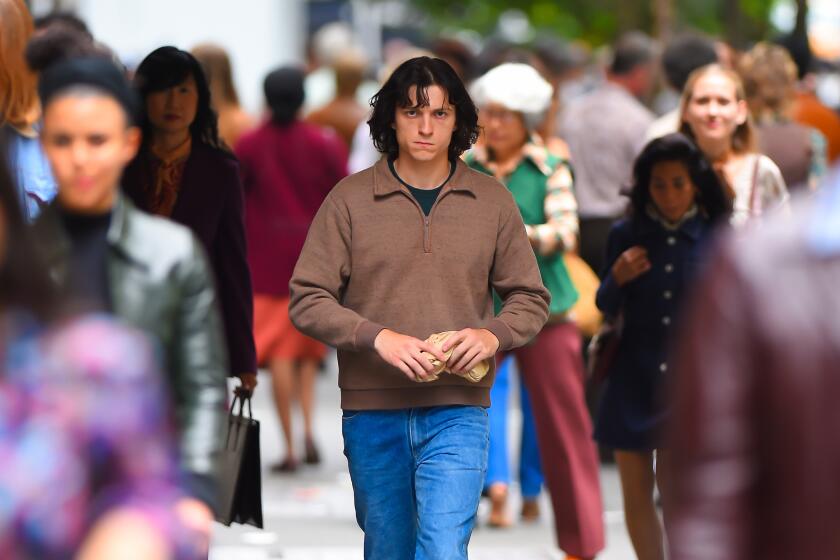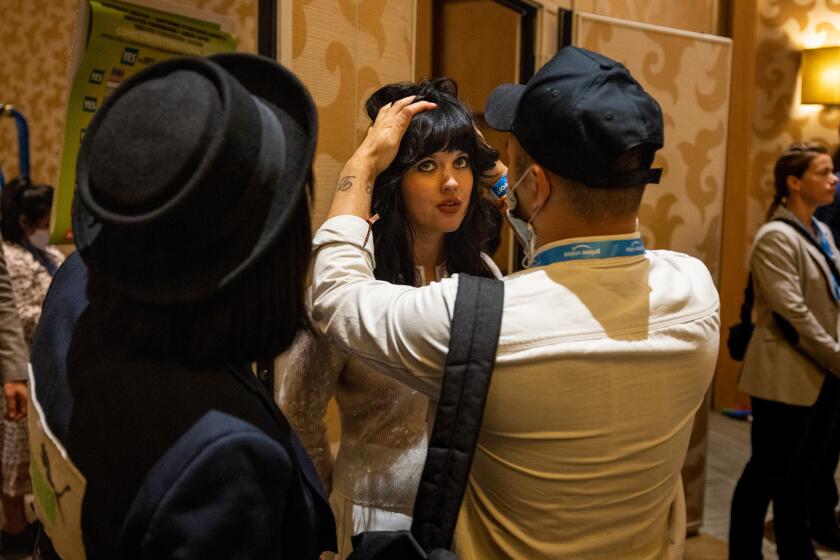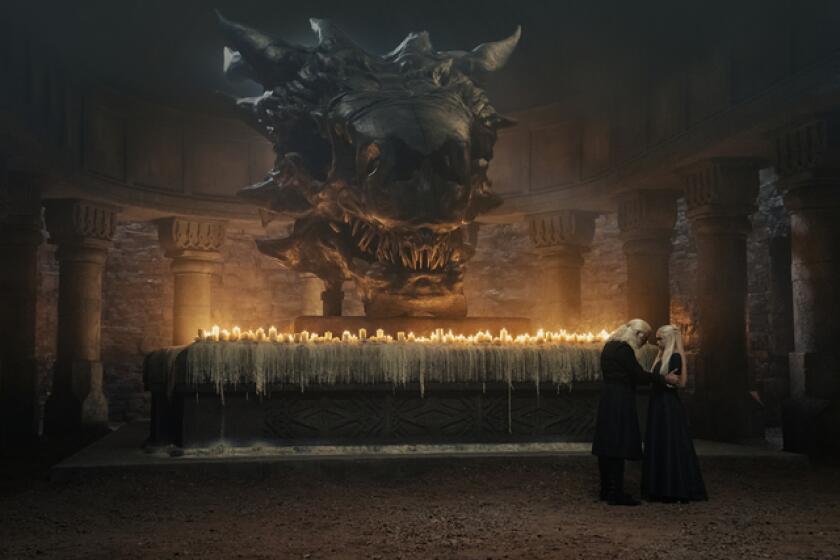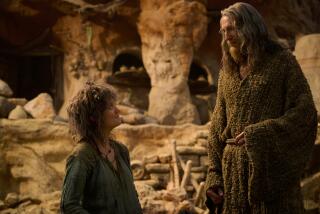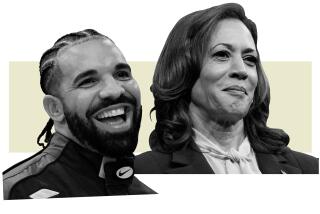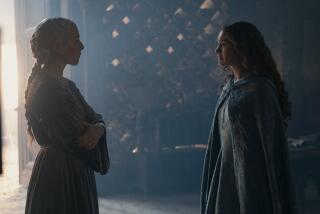Column: What color is an elf? Or a Sea Snake? And why do you care?
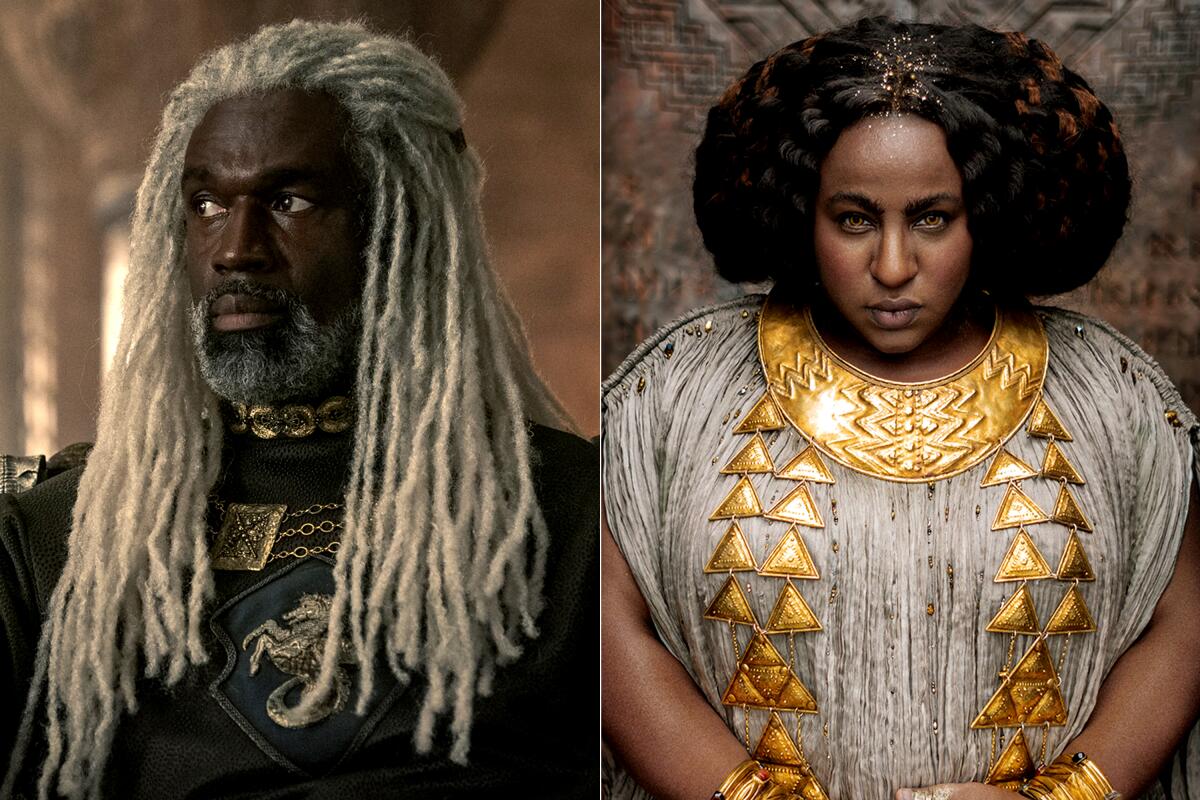
- Share via
When attacked on social media for having the temerity to play Lord Corlys Velaryon on “House of the Dragon” while Black, Steve Toussaint replied the only way a thinking actor could: “They are happy with a dragon flying,” he said during a recent interview in Men’s Health. “They’re happy with white hair and violet-colored eyes, but a rich Black guy? That’s beyond the pale.”
Beyond the pale indeed; not only does Toussaint nail the wily and ambitious “Sea Snake” in early episodes, he’s pretty much the only member of the cast who looks natural under one of those Targaryen-blond wig hats.
Also, no one has violet eyes except the late great Elizabeth Taylor.
Since obedience to original material is almost always used to justify outrage over a person of color playing an adapted character who was, or was assumed to be, white, it is important to acknowledge the etymological root of the term Toussaint used.
“The pale” originally referred to the boundaries that surround the English-invader-settlement that would become Dublin, Ireland. Outside those boundaries lived the native Irish, whom the British considered lawless savages.
So “beyond the pale” is, essentially, a racist term. Which makes perfect sense here.
A spate of stars withdrawing from the public eye reminds us of what we already know: Fame has a price and social media only adds to the anxiety.
It is equally important to acknowledge that if certain people are upset over a Black man playing a character who occupies a place of power in Westeros, I don’t know what their reaction will be when they get a look at Amazon’s version of Middle-earth. Perhaps something like that famous scene in “Scanners.”
Long before the series’ Sept. 1 streaming premiere, the term “woke” was being thrown about with the usual idiotic abandon.
In “The Lord of the Rings: The Rings of Power,” actors of color play all sorts of characters — elves, dwarves, humans and harfoots (who would, we assume, later become known as hobbits). These, rather than, say, Black, white, Asian, etc., are the racial divisions which J.R.R. Tolkien used to tell his epic tale of how the inhabitants of Middle-earth put aside historical hatreds to fight a common enemy.
If all or most of Tolkien’s original humanoid characters were depicted as white in his books, well, he was a British scholar using Norse tradition to create a British mythology, so racial homogeny was built right in. George R.R. Martin has said he, like many other modern fantasy writers, was inspired by Tolkien, and that his Ice and Fire saga is rooted loosely in the British Isles.
Still, Tolkien, having lived through two world wars, celebrated his own version of multiracial unity — just as “A Song of Ice and Fire” is, at heart, the story of warring tribes finally realizing that they are stronger when united.
This makes any outrage over what is unfortunately still known as “diversity casting” even more ridiculous. You can’t argue allegiance to an original work when you are so clearly missing its main message.
As Toussaint and many others have pointed out, neither works are historical, and if the word “fantasy” doesn’t offer enough freedom to play around with how things and people look or sound, then the word “adapted” should.
“House of the Dragon” star Steve Toussaint discusses the racism he faced after being cast in the “Game of Thrones” prequel: “A rich Black guy? That’s beyond the pale.”
I would argue that, in hindsight, both “Game of Thrones” and Peter Jackson’s “Lord of the Rings” could easily have included more actors of color. As each story revolves around the perils and power of racial or clannish identity, their sequels would naturally call for advances in inclusion of all kinds.
But the fans, oh the fans, and their deeply personal and emotional expectations.
Please. Superfans of any book will always have objections to how it is adapted to film or television. I too wept when I learned that Tom Bombadil did not make the final cut of “LoTR,” and was really looking forward to the appearance of Lady Stoneheart in “GoT.” But taking issue with the physical traits of the actors is absurd.
Half the time the fans are wrong: Remember the shock and horror some of the more racist “Hunger Games” fans expressed when Amandla Stenberg played Rue? Even though Rue was described as having dark skin?
Either way, it shouldn’t matter. They’re actors, for heaven’s sake. Harry Potter had black hair and green eyes which were a Very Big Deal in the books; as embodied by Daniel Radcliffe, his hair was brown and his eyes blue and life as we know it did not end.
(No one is saying casting should always be random. But calls for authentically casting underrepresented roles — in the case of trans, gay, deaf, neurodivergent or disabled characters — are in no way analogous to the protests over Toussaint. No one is an actual Targaryen or a wood elf or a citizen of Khazad-dum, so no actor has any particular insight into any of these parts.)
The Times goes behind the scenes at San Diego Comic-Con with the cast of Prime Video’s spinoff, ‘The Rings of Power,’ in this exclusive photo essay.
The whole point of adaptations is to bring a glorious story to life in a new way, to celebrate its timelessness and deliver it to a new audience. Both “House of the Dragon” and “Rings of Power” are prequels, so there is an argument to be made about internal continuity. But is that honestly a wormhole worth following? Do we really not understand the definition of fiction?
The trick of any successful adaptation is to stay true to the spirit of the original; if you’re not trying to expand the story in some way, why bother?
No matter how much we love our classics, our genre touchstones, there is no denying that most of them were written or created in a time when white men, and stories about white men, dominated the cultural narrative. Moving forward, we need to expand our definition of “classic” and “touchstone ” to include all the world that exists “beyond the pale.” And that expansion must include re-imagining the beloved works.
Any attempt to make our storytelling better reflect the actual world, to use our myths to discover truly universal truths, is going to look and feel different. It has to; stories, like everything else on this planet, must change to survive.
If we want to keep hold of those touchstones, like “Lord of the Rings” and “Game of Thrones,” modern adaptations will have to look and feel different too.
So if you’re expressing “respect the original material” outrage over a Black actor playing a Velaryon or an Afro-Iranian playing a Dwarven princess, you might want to remember what happened to those original-material characters who refused to acknowledge that the world had changed. Because it wasn’t good.
In Screen Gab No. 48, we explain how ‘House of the Dragon’ relates to ‘Game of Thrones,’ recommend two titles to check out this weekend, and more.
More to Read
The biggest entertainment stories
Get our big stories about Hollywood, film, television, music, arts, culture and more right in your inbox as soon as they publish.
You may occasionally receive promotional content from the Los Angeles Times.
